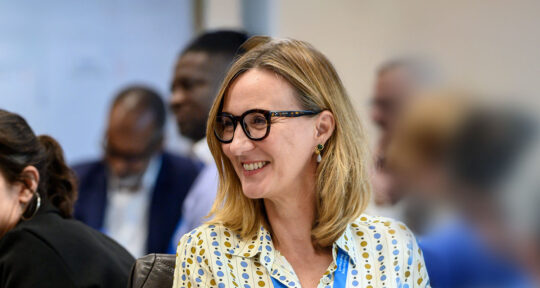Have you ever noticed a shift on the horizon—like a new digital trend or a change in customer behaviour—and adjusted your approach before things got complicated? Or, perhaps planned ahead for supply chain issues while others were still reacting? These are not just good instincts; they are clear examples of strategic thinking in action.
This article explores six practical ways to develop and master strategic thinking skills. Whether you’re a senior executive or an emerging leader, these habits can help you drive long-term success—and contribute meaningfully to your organisation’s future.
What you’ll learn in this article:
- What is strategic thinking?
- What makes someone a strategic thinker?
- What is strategic thinking in leadership?
- Six ways to strengthen your strategic mindset
- From theory to practice
What is strategic thinking?
At its core, strategic thinking is an intentional and rational thought process that focuses on analysing critical factors and variables to ensure long-term success. This includes anticipating threats, identifying opportunities, and aligning actions with overarching goals.
If you’ve ever asked yourself how to think strategically, the answer begins with cultivating awareness, curiosity, and a willingness to challenge conventional thinking. It blends creativity with logic and encourages leaders to move beyond short-term problem solving to adopt a broader, more proactive approach.
Strategic thinking is not limited to isolated decisions; it is a continuous mindset that shapes how leaders evaluate situations, allocate resources, and set priorities over time. It requires balancing immediate demands with future opportunities, ensuring that every action taken today is aligned with a longer-term vision.
Leaders who cultivate strategic thinking are better equipped to navigate uncertainty, adapt to evolving environments, and drive sustainable growth for their organisations.
What makes someone a strategic thinker?
A strategic thinker is someone who consistently applies long-term, forward-looking thinking to complex situations—anticipating change, aligning actions with broader goals, and making decisions that create lasting value.change, aligning actions with broader goals, and making decisions that create lasting value.
In today’s business landscape, change is the only constant. New technologies, evolving customer expectations, and global disruptions challenge leaders to think several steps ahead. This is where strategic thinking becomes not just an advantage—but a necessity. Strategic thinkers are better equipped to anticipate shifts, design resilient plans, and lead with purpose.
Strategic thinking goes beyond planning—it’s one of the core leadership skills. It enables individuals to align decisions with long-term goals, respond to complexity with clarity, and foster innovation across their organisations. But understanding the concept isn’t enough. To truly make an impact, leaders must apply these principles consistently, in both everyday decisions and high-stakes situations.
Being a strategic thinker means putting this mindset into practice. It’s about navigating ambiguity, thinking ahead, and continuously looking for better ways to solve problems and create value.
While strategic thinkers vary in background and style, they often share a few defining traits:
- Comfort with uncertainty and complexity
- Strong analytical and problem-solving abilities
- Openness to new perspectives and change
- A focus on long-term impact over short-term gains
What is strategic thinking in leadership?
Strategic thinking in leadership is the ability to apply long-term, forward-looking thinking to guide teams and organisations through complexity. It means making decisions that align with a broader vision—while anticipating change and managing uncertainty.
Leaders who think strategically don’t just react to challenges. They anticipate what’s coming, set priorities that support long-term goals, and adjust when needed.
This mindset also involves aligning people and resources. Strategic leaders bring people together around a common goal and align their efforts to drive meaningful outcomes.
Whether deciding where to invest, how to motivate teams, or how to navigate market shifts, strategic thinking helps leaders act with clarity, focus, and intention.

Six ways to strengthen your strategic mindset
Now that we’ve explored what strategic thinking is and why it matters, let’s look at six practical ways that can help you strengthen your strategic mindset and lead more effectively:
1. Build awareness of the bigger picture
One of the most important strategic thinking skills is the ability to see beyond the day-to-day. Strategic thinkers cultivate awareness of industry trends, market movements, geopolitical shifts, and technological changes. This macro-level perspective helps them make decisions that align with long-term objectives.
Tactics to expand your perspective:
- Read industry reports and market analyses regularly
- Follow thought leaders in your field
- Attend conferences or webinars on global trends
- Subscribe to curated newsletters (e.g. innovation, finance, geopolitics)
2. Ask better questions
Developing strong strategic thinking skills often starts with curiosity—not bold declarations. “Ask better questions” may sound straightforward, but it’s often one of the most overlooked and powerful habits to build.
Instead of simply reacting to problems, strategic thinkers often pause to ask:
- What are the long-term implications of this decision?
- What trends could influence our industry in the next five years?
- Are we solving the right problem, or just a symptom?
- What if we did the opposite of what we’re considering?
- Who benefits—and who doesn’t—from our current approach?
By building a habit of inquiry, you sharpen your ability to identify root causes and surface overlooked risks or opportunities. A structured approach can make your questioning even more effective.
Discover IMD’s Leader’s Question Mix, developed by our expert faculty Arnaud Chevallier and Frédéric Dalsace, this tool provides a practical framework to refine your questioning style.
It helps leaders assess the balance of their current inquiry approach and master the five essential types of questions—investigative, speculative, productive, interpretive, and subjective—to improve strategic clarity and decision-making.
Learn more about the strategic planning process in business»
3. Explore scenarios and alternatives
Scenario planning is one of the most practical strategic thinking examples. By imagining multiple possible futures, leaders can prepare for uncertainty rather than be surprised by it. What if a key supplier fails? What if a competitor launches a disruptive product?
Simple methods to start scenario planning:
- Identify two key uncertainties in your environment
- Map best-case, worst-case, and most likely scenarios
- Brainstorm possible responses with your team
- Monitor indicators that signal which scenario is unfolding
Scenario planning not only sharpens your foresight but also builds team agility. Frameworks like the Business Model Canvas can further support this process by offering a clear view of how different elements of a business interact and evolve over time. When employees are exposed to strategic conversations early, they are better prepared to act decisively when change arrives.
4. Adopt systems thinking
Strategic thinkers understand that businesses are complex systems—interconnected and interdependent. Systems thinking means identifying how decisions in one area ripple across others. For example, a change in pricing might impact sales volumes, logistics capacity, and even customer loyalty.
A helpful model here is the McKinsey 7s Model, which shows how strategy interacts with structure, systems, skills, style, staff, and shared values. By evaluating all seven elements, leaders can ensure alignment and identify hidden tensions.
Possible applications of systems thinking in leadership:
- Aligning your culture with strategic priorities: Ensuring that your team’s values and behaviours reinforce—not contradict—your long-term goals.
- Detecting bottlenecks that prevent cross-team collaboration: Uncovering hidden friction points in processes or communication that slow progress.
- Forecasting unintended consequences of organisational change: Anticipating ripple effects before they impact morale, performance, or customer satisfaction.
5. Learn from strategic peers
No one develops strategic thinking in isolation. Surrounding yourself with other strategic thinkers—mentors, colleagues, diverse teams—can accelerate your growth. Engage in discussions that challenge your thinking, expose you to different approaches, and push you outside your comfort zone.
Strategies to build your strategic network:
- Join industry associations or online communities
- Attend workshops or executive education programmes
- Schedule regular coffee chats with cross-functional peers
- Follow global case studies and reflect on the strategic moves involved
6. Reflect and iterate regularly
Strategic thinking isn’t just about bold visions—it’s also about learning from the past. Strategic thinkers should make time to reflect: What worked? What didn’t? What will I do differently next time?
In this case, here are some ways to build reflective habits:
- Keep a strategic journal to track insights and lessons learned
- Conduct post-mortems after major projects
- Review key decisions every quarter
- Ask for feedback from stakeholders across levels
This is also where strategic thinking vs critical thinking come together. Critical thinking hones your ability to analyse. Strategic thinking ensures that analysis translates into meaningful, future-focused decisions.
From theory to practice
In a world where change is constant, the ability to think strategically is no longer a competitive advantage — it is a necessity. The best strategists are not just planners. They are adaptive thinkers who learn, reflect, and evolve as they go.
IMD’s Strategic Thinking program helps you develop this mindset. Through real-world challenges, hands-on tools, and expert coaching, you will learn how to navigate complexity and lead with greater clarity and confidence.
Stay up to date 💌
Join the IMD Community.
Stay informed with our latest insights on leadership, strategy, digital transformation and more. Explore fresh perspectives from IMD business school to help you navigate today’s complex business landscape.




